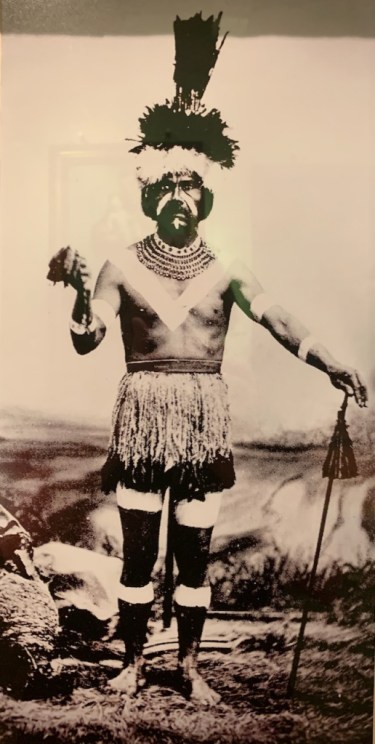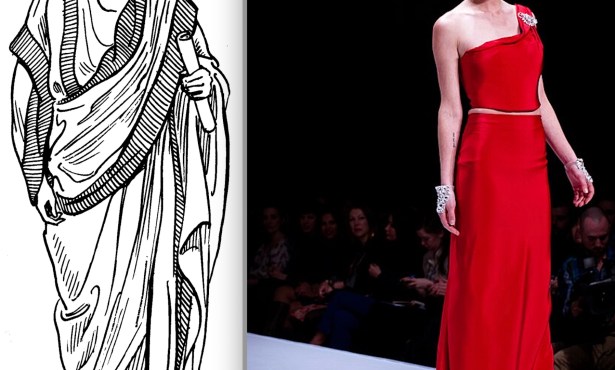Sure, We Celebrate Old Spanish Days, but What About Old Chumash Days?
Viva La Fiesta
Santa Barbarians enjoy shouting “Viva La Fiesta!” as we celebrate Old Spanish Days — but what if we also celebrated Old Chumash Days? What would we shout then? Speaking for myself, I knew nothing about Chumash culture until I began researching it. So here’s part of what I learned — in the form of a quiz.

(1) Who built Old Mission Santa Barbara?
(a) Google this question and you will read that it was founded by the Franciscan Friars, which gives the impression that a few old Spanish guys were able to roll and carve all the stones needed to build the Old Mission. To find out who the actual builders were, you have to dig a little deeper — as in, read the next sentence.
(b) A rock band called Barbareños. Barbareños is what the Friars called the Santa Barbara Chumash. I didn’t make that name up. But I did substitute the synonym “band” for “tribe.” The “rock” reference in the answer comes from the fact that the Chumash were well known to be rock artists — obviously not in the same sense as the Rolling Stones, though the Chumash did, in fact, roll stones.
(2) The Friars reorganized the California tribes, replacing their traditional Indigenous names with Spanish names, a colonial renaming which reflected the missions they worked at. The California Chumash were divided into different groups called:
(a) The Padres, the Angels, and the Warriors.
(b) The Ineseño, the Barbareño, and the Ventureño, to name only three. Respectively, these were Chumash who built and ran the missions in Santa Ynez, Santa Barbara, and San Buenaventura. In addition to their brilliant rock art, the Chumash were also famous for their complex basket weaving — their work is displayed in museums around the world. They were also known for an economic system they invented, and for which they were apparently named.
(3) What does “Chumash” mean?
(a) “Eat Drink Man Woman”
(b) “Shell Bead Money Maker” — The Chumash created shell beads which they used as money, called ’alchum, which they used to trade for goods with other tribes. ‘Alchum has been found as far away as New Mexico. The Chumash built plank canoes (which they called tomols) instead of the more common dugouts because tomols were better suited for traveling along the coast and could carry more of the products the Chumash traded and purchased.
(4) How did the Chumash water-proof their tomols?
(a) They used a glue suggested to them by the helpful clerks at our downtown Home Improvement Center — those guys really do know everything!
(b) They used malak. Chumash commonly used “pismu,” or raw petroleum, of which their language described two types: “wogo,” found on land, and “malak,” which washed up on beaches near their villages and which they used to waterproof their tomols. Their villages usually consisted of a few hundred people, had a playing field called a malamtepupi where they played tikawich (similar to lacrosse), and many villages had a paxa’ (a spiritual leader), and a wot.
(5) What is a “wot”?
(a) Obviously, “What is a wot?” is the name of a long-lost Abbott and Costello comic dialogue, a sequel to their “Who’s on first?” routine.
(b) A wot is a chief of a tribe, usually hereditarily determined; they were mostly men, but women were also wots.
(6) Did the Chumash use ‘aps?
(a) ’Aps were devices on Chumash phones which allowed them to find the nearest malamtepupi, play virtual tikawich games, and contact their wots and paxa’s.
(b) ‘Aps were their homes, dome-shaped shelters made of willow branches and tule reeds which held four to 50 people, and were ventilated and divided into separate spaces. Their ‘aps were part of a sustainable lifestyle which evolved for 13,000 years. Until 1769.
(7) What happened in 1769?
(a) Keith Richards was born. (A human Rolling Stone. See Question 1.)
(b) Spain began setting up missions in California, and many Chumash were made to live and work on their grounds. Chumash land was taken away, and their freedom of movement ended — in short, their village lifestyle was destroyed.
(8) On the “Mission and History” page of the current official Old Mission website, how many times does the word “Chumash” appear?
(a) Too many to count.
(b) Zero
(9) According to the Old Mission website, the Mission “bears witness to the Franciscan tradition, practicing radical hospitality.” What does the term “radical hospitality” mean?
(a) “Radical hospitality” is a description of what happened when one of the Chicago Seven invited you over for dinner.
(b) “Radical hospitality,” in Christian theology, is commonly defined as an “extraordinary effort and emphasis on making people feel welcome.” Thus the Spanish Friars made the Chumash feel welcome by taking their land, forcing them to leave their villages, altering their sustaining diets and cultural practices, and changing their religious beliefs — so the Chumash could build and maintain missions for the Friars. That certainly puts the “radical” in “radical hospitality”.
(10) When California was taken over by the United States, how did the treatment of the Chumash change?
(a) They lived happily ever after.
(b) It got worse. On January 7, 1851, the Governor of California, Peter H. Burnett, stated, “That a war of extermination will continue to be waged between the races until the Indian race becomes extinct…”
Viva La Fiesta.
Note: Obviously, the correct answer to all these questions is “b.” However, after learning what kind of “radical hospitality” the Chumash received from the Friars, I think the more accurate answer to question 9 might actually be “a” — to have had dinner at Abbie Hoffman’s.




You must be logged in to post a comment.